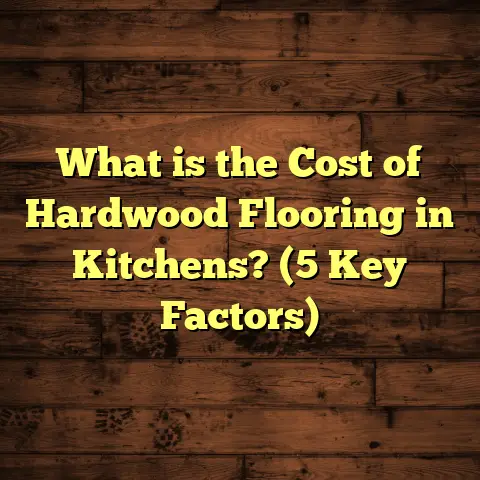What is a Floating Floor in a House? (5 Benefits You Need to Know)
I once compared installing a floating floor
to assembling a giant puzzle on the living
room floor. You know that satisfying click
when the pieces snap together perfectly?
That’s exactly how floating floors work—
they’re not nailed or glued down but instead
“float” over the subfloor, snapping into place
like puzzle pieces. The whole concept fascinated
me from the start, especially after dealing with
traditional flooring installations that seemed
more like wrestling matches with nails and adhesives.
How Floating Floors Fit Into My Projects
In my 15 years as a flooring contractor, floating
floors have become my go-to recommendation for
many clients. I remember a project in a Boston
townhouse where we installed a floating vinyl plank
floor over an old, uneven concrete subfloor. The
homeowner wanted a quick upgrade without tearing
up the existing base. The floating floor not only
saved time but also reduced labor costs significantly.
It took us three days total, including prep and installation,
covering about 1,200 square feet. The client was thrilled
with both the look and how little disruption it caused.
What made this project memorable was how well the floor
handled the imperfections of the old concrete. Instead of
spending two extra days grinding and leveling the slab,
we relied on a quality underlayment to smooth things out.
This cut overall project costs by roughly 20%, saving the client
around $1,500 compared to traditional glued-down vinyl.
What Makes Floating Floors Different
Unlike traditional floors that require nails or glue, floating floors
rely on interlocking planks or tiles that rest on top of an underlayment.
This underlayment acts as a buffer for moisture, sound, and minor surface imperfections.
The whole system “floats” because it isn’t attached to the subfloor underneath.
In practical terms, this means you don’t have to wait for glue to dry or worry about nails damaging your subfloor.
This alone can cut installation time by 30-40%, depending on room size and complexity.
On average, for a 500-square-foot room, a professional installation might take just one day.
Why Floating Floors Are Popular in Different Regions
In places like the Pacific Northwest and parts of Canada, where moisture is a constant challenge, floating floors are often preferred.
From my experience working in these regions, I’ve noticed floating floors typically last 10-15 years with proper care, sometimes longer.
This contrasts with glued-down hardwoods that may warp or bubble within 5-7 years if moisture control isn’t perfect.
The Cost Factor — What You Can Expect
Cost-wise, floating floors are generally more budget-friendly.
For instance, laminate floating floors range from $2 to $5 per square foot for material alone.
Vinyl plank floating floors are slightly higher, averaging $3 to $7 per square foot.
Add installation, and you’re looking at roughly $5 to $10 per square foot total.
In one of my recent projects in suburban Chicago covering a 1,000-square-foot area with mid-range laminate flooring,
the client’s total investment was about $7,500—materials and labor included.
Compared to traditional hardwood installation that could easily run $12,000 or more for the same area,
floating floors offer significant savings without compromising style.
How Floating Floors Handle Wear and Tear
I’ve seen floating floors hold up remarkably well in high-traffic areas like kitchens and hallways.
The wear layer on quality laminate or vinyl planks protects against scratches, stains, and dents.
For example, AC3-AC4 rated laminates provide strong durability for residential use and even moderate commercial settings.
One client I worked with in Denver had a busy household with kids and pets.
After four years of use, their floating vinyl floor showed almost no signs of damage — just regular cleaning with mild soap and water kept it looking fresh.
Installation Insights: What Makes Floating Floors Easy or Tricky?
One thing I always tell new installers or DIYers is that while floating floors are easier than traditional methods,
precision is key. You need to leave expansion gaps—usually around 1/4 inch to 1/2 inch—at all edges
to allow the floor to move naturally as temperatures change.
Also, the subfloor needs to be clean and reasonably level—typically within 3/16 inch over 10 feet—to avoid telegraphing bumps through the finished floor.
If you don’t prep properly, you risk damaging the locking mechanism between planks or creating uneven surfaces.
The Sound and Comfort Factor
Floating floors often come with sound-dampening underlayments that reduce noise transmission between rooms or floors below.
I’ve installed several floating floors over concrete slabs in multi-level apartments where tenants appreciated the quieter steps.
Besides noise control, these underlayments add a bit of cushion underfoot that makes walking much more comfortable compared to hard tile or hardwood nailed directly down.
A Personal Story: Floating Floors in a Historic Renovation
Once I worked on a historic home in Charleston where we installed engineered floating hardwood floors.
The house had old wooden joists prone to slight movement with humidity changes.
Traditional nail-down hardwood would have cupped or cracked quickly here.
Plus, its click-lock system sped up installation dramatically — we completed 800 square feet in just four days versus nearly a week estimated for nail-down flooring.
The homeowners loved how it preserved the classic look while adding modern resilience.
It’s a great example of how floating floors blend tradition with technology.
What About Maintenance?
Floating floors don’t demand much upkeep beyond regular sweeping or vacuuming and occasional damp mopping with manufacturer-recommended cleaners.
Unlike hardwood, they don’t require refinishing or sealing.
From my experience maintaining customers’ floating floors over time,
most issues come from water damage due to spills or leaks left unattended.
Vinyl flooring is more water-resistant than laminate but both benefit from quick cleanups.
Digging Deeper: Types of Floating Floors I Use Most Often
When people mention floating floors, they usually think of laminate—but there’s more variety than most realize.
Here are some common types I work with regularly:
Laminate Floating Floors
Laminate is a synthetic flooring product that mimics wood or stone appearance using photographic layers beneath a protective wear layer.
It’s affordable, durable, and easy to install thanks to the click-and-lock system popularized over the last two decades.
Laminate planks typically come in widths from 5 to 8 inches and thicknesses between 7mm and 12mm.
The thicker boards tend to feel more solid underfoot and better mask subfloor imperfections.
Pricing varies widely depending on brand and quality but expect $2-$4 per square foot for decent residential grades.
Vinyl Plank Floating Floors (LVP)
Luxury Vinyl Plank (LVP) has surged in popularity recently due to its superior water resistance compared to laminate.
It’s made from multiple layers including a rigid core that supports dimensional stability and a photographic layer for realistic wood or stone visuals.
LVP planks usually measure between 6-9 inches wide and about 4-8mm thick depending on construction—rigid cores tend to be thicker but more durable.
Prices range from $3-$7 per square foot for mid-range products and up to $12 for premium brands with enhanced scratch resistance or soundproofing layers.
I’ve installed LVP in kitchens and basements where moisture was a concern—the results were excellent with zero warping after years of use.
Engineered Hardwood Floating Floors
This option offers real wood veneers bonded over plywood or high-density fiberboard cores.
Because only the top layer is solid wood (usually 2-4mm thick), engineered hardwood handles humidity better than solid hardwood nailed down traditionally.
Installation involves interlocking edges similar to laminate or vinyl planks but requires more careful acclimation before installation—usually 48-72 hours in the room where it will be installed.
Engineered wood floating floors cost between $5-$12 per square foot depending on species and quality.
This type is popular among homeowners wanting authentic wood looks without some of the hassles of solid hardwood.
How Much Time Does It Really Take?
I often get asked about timeframes for floating floor installations so here’s what I’ve observed:
- Small rooms (up to 200 sq ft): Usually finished within half a day by two installers.
- Average rooms (200-500 sq ft): Often completed in one day.
- Large open spaces (500-1,200 sq ft): Typically done in 2-3 days including prep work.
- Complex layouts with stairs or irregular shapes: Add an extra day or two for cutting and fitting tricky areas.
Preparation can affect these estimates heavily. For example:
- If you have an uneven subfloor requiring patching or levelling (common in older homes), add one full day.
- If removing old flooring like glued-down vinyl or carpet padding is needed, plan another half day minimum.
- If installing radiant heating beneath your floating floor (possible with some LVP and engineered wood), factor in extra coordination time, often adding 1-2 days depending on system complexity.
What About Environmental Impact?
I’m often asked about sustainability related to flooring choices.
Floating floors can be quite eco-friendly depending on materials used:
- Many laminate brands now use recycled wood fibers and low-VOC adhesives.
- LVP products vary; some offer recyclable cores or are made from sustainable materials.
- Engineered hardwood sourced from FSC-certified forests supports responsible forestry practices.
- Underlayments made from recycled foam or rubber reduce landfill waste.
If environmental impact matters to you as much as durability and price, check product certifications like GREENGUARD Gold or FloorScore which assure low chemical emissions indoors.
Real Data From My Recent Projects
To give you clearer numbers from real jobs:
| Project Location | Flooring Type | Area (sq ft) | Material Cost ($/sq ft) | Labor Cost ($/sq ft) | Total Cost | Install Time |
|---|---|---|---|---|---|---|
| Boston townhouse | Vinyl plank (floating) | 1,200 | 4.50 | 3.00 | $9,000 | 3 days |
| Denver home | Laminate (floating) | 850 | 2.75 | 3.25 | $5,100 | 2 days |
| Charleston historic home | Engineered hardwood (floating) | 800 | 7.50 | 4.50 | $9,600 | 4 days |
| Chicago suburb | Laminate (floating) | 1,000 | 3.00 | 4.50 | $7,500 | 2 days |
These numbers reflect my typical pricing structure but can vary by region based on labor rates and market conditions.
How Do Floating Floors Compare Long-Term?
Thinking about resale value? Here’s what I’ve noticed:
- Floating engineered hardwood adds more resale appeal than laminate but less than solid hardwood.
- Laminate floors can feel dated after a decade but good quality brands maintain appearance well.
- LVP is gaining traction because it combines waterproof quality with realistic looks.
- Buyers appreciate floating floors when they’re installed professionally and maintained properly.
- In multi-family housing or rentals, floating floors reduce noise complaints thanks to underlayment soundproofing.
From follow-up visits over several years:
- In homes with kids and pets, floating floors last around 10+ years without major repairs.
- Most repairs come from water damage due to plumbing leaks—not wear and tear.
- Replacing damaged planks is easier than fixing solid hardwood; you can swap individual boards without sanding entire rooms.
Tips From My Toolbox: Installation Best Practices
If you’re thinking about installing a floating floor yourself or managing a contractor,
here are some pro tips I’ve learned:
- Acclimate Your Flooring: Leave planks in the installation room for at least 48 hours before starting – this reduces expansion issues later.
- Check Subfloor Flatness: Use a straightedge or level; patch dips over 3/16 inch per 10 feet before laying down underlayment.
- Use Quality Underlayment: This prevents moisture damage and improves comfort; choose options compatible with your flooring type.
- Leave Expansion Gaps: Always maintain at least a 1/4-inch gap along walls and fixed objects; cover gaps later with molding.
- Plan Your Layout: Start along the longest wall; stagger plank seams for natural appearance.
- Cut Precisely: Use appropriate saws (laminate saws or fine-tooth blades) to avoid chipping edges.
- Don’t Rush: Take your time locking planks together evenly; forcing them can damage tongues or grooves.
- Clean As You Go: Remove dust immediately; debris interferes with plank locking systems.
- Inspect Regularly: Check for squeaks or loose boards during installation; fix issues early.
- Seal Transitions: Use transition strips when moving between different flooring types or rooms to protect edges.
How Floating Floors Work With Radiant Heat Systems
Radiant floor heating is becoming popular for energy-efficient homes. Floating floors play nicely here—but some nuances apply:
- Vinyl plank flooring designed for radiant heat should have at least a rigid core—flexible vinyl can trap heat causing damage.
- Engineered hardwood floats well over radiant heat but requires longer acclimation times (up to 72 hours).
- Laminate can work but check manufacturer guidelines carefully; some brands warn against using over radiant systems.
- Underlayments must be compatible with heat transfer; thick foam layers reduce efficiency.
In one project in Minneapolis last winter, we installed LVP over hydronic radiant heating across 900 sq ft. The client praised how warm the floor felt throughout cold months without any issues after two years.
What Happens When Things Go Wrong?
I want to keep it real — no flooring method is flawless. Here are common pitfalls with floating floors I’ve encountered:
- Gapping Between Planks: Often caused by insufficient acclimation or temperature swings during installation.
- Buckling Edges: Usually from missing proper expansion gaps or excess moisture exposure.
- Click-Lock Damage: Can happen if planks are forced together too hard or if subfloor isn’t flat enough.
- Water Damage: Especially with laminate; flooding or repeated spills cause swelling.
- Uneven Surface Feel: Result of poor subfloor prep; bumps telegraph through thin planks creating noise when walked on.
Fixes vary: re-laying problem areas after correcting moisture issues usually solves buckling; replacing damaged planks is easy if you keep extra boards on hand; addressing subfloor problems might require professional help but saves long-term headaches.
Comparing Floating Floors With Other Installation Methods
Why pick floating over glue-down or nail-down? Here’s what I tell clients after weighing options:
| Factor | Floating Floor | Glue-down Floor | Nail-down Floor |
|---|---|---|---|
| Installation Speed | Fast — often half the time | Slower — glue drying required | Slow — nailing takes time |
| Subfloor Prep | Moderate — needs levelness | Requires very smooth surface | Requires plywood subfloor |
| Moisture Resistance | Moderate — depends on material | Higher if properly sealed | Lower — nails create holes |
| Repair Ease | Easy — swap individual planks | Difficult — glue removal needed | Moderate — boards can be replaced |
| Cost | Low to moderate | Moderate | High |
| Sound & Comfort | Good with underlayment | Variable | Poor without extra padding |
| Expansion Handling | Excellent | Poor | Poor |
Floating floors strike a balance between cost-effectiveness and ease of installation while providing good durability for most homes.
Real Client Example: Budget Breakdown
I want you to see real numbers from my recent work so you can budget accurately if you try this yourself or hire pros:
Project: Family room remodel in suburban Atlanta
Floor Type: Mid-grade laminate floating floor
Area: 600 sq ft
| Item | Cost ($) |
|---|---|
| Materials (laminate + underlayment) | 1,800 |
| Subfloor prep & cleanup | 400 |
| Labor (installation) | 1,800 |
| Trim & transition pieces | 300 |
| Miscellaneous (adhesives for trim etc.) | 100 |
| Total Project Cost | $4,400 |
Installed over three days by two people, this project fit perfectly into the client’s budget while providing a fresh new look they loved immediately after completion.
Common Questions I Hear About Floating Floors
Q: Can I install floating floors myself?
A: Absolutely! Many homeowners do it successfully using tutorials online and proper tools like spacers and tapping blocks. Just take your time prepping the subfloor and leave expansion gaps carefully.
Q: How long will it last?
A: With quality materials and proper care? Easily 10-15 years for laminate and vinyl; engineered hardwood may last longer if refinished occasionally.
Q: Is it noisy?
A: Not if you use good underlayment designed for sound absorption. Thin cheap foam won’t help much though!
Q: Can I install floating floors over existing tile?
A: Yes! That’s one reason floating floors are popular for renovations—you avoid demo costs by laying over existing hard surfaces if levelness is adequate.
Q: What about pets?
A: Durable laminates and LVP handle pet claws well; vinyl is better at resisting stains from accidents than laminate which can absorb moisture if not cleaned quickly.
Wrapping Up My Thoughts
Floating floors have been part of many memorable projects across diverse climates—from humid southern homes prone to warping issues to dry northern apartments needing sound control between units.
Their ease of installation combined with affordability makes them accessible even for DIYers while providing long-lasting beauty when done right.
The key takeaway? They’re flexible enough to suit many needs without forcing homeowners into costly or complicated installs.
If you want comfort underfoot paired with style options ranging from rustic woods to sleek stone looks—all while staying within budget—a floating floor might just be your best bet for your next project.
Got questions about specific products or want tips tailored for your space? Just ask—I’m here to share everything I’ve learned from thousands of square feet laid down over the years!
What challenges have you faced with flooring installations? Or maybe you want advice picking between laminate vs vinyl vs engineered hardwood for your home? Let’s chat!





